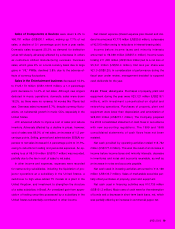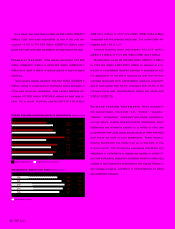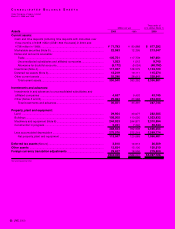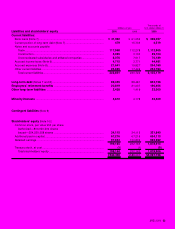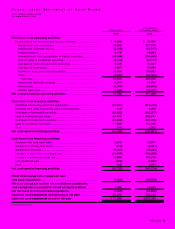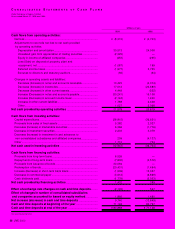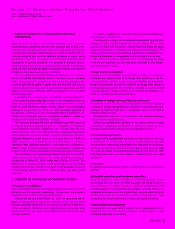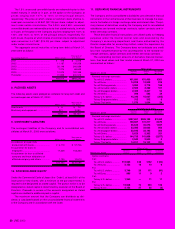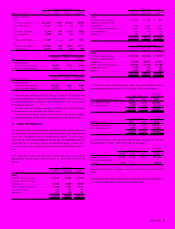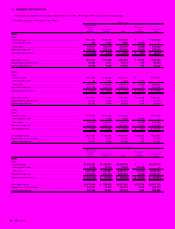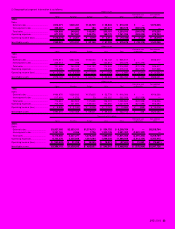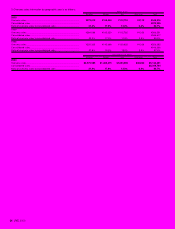JVC 2000 Annual Report Download - page 30
Download and view the complete annual report
Please find page 30 of the 2000 JVC annual report below. You can navigate through the pages in the report by either clicking on the pages listed below, or by using the keyword search tool below to find specific information within the annual report.
28 JVC 2000
The ranges of useful lives for computing depreciation are generally
as follows:
Buildings ...................................................................... 20 to 50 years
Machinery and equipment............................................ 3 to 7 years
Expenditures for maintenance and repairs are charged to income as
incurred.
Software costs
In accordance with the provisional rule of the JICPA’s Accounting
Committee Report No.12 “Practical Guidance for Accounting for
Research and Development Costs, etc.” (the “Report”), the Company
accounts for software which was included in long-term prepaid ex-
penses in investments and other in the same manner in 2000 as in
1999. Pursuant to the Report, however, the Company included
software in intangible assets in 2000. Software costs are amortized
using the straight-line method over the estimated useful lives (three to
five years). The amount for 1999 has been reclassified to conform to
the 2000 presentation.
Finance leases
Finance leases, except those leases for which the ownership of the
leased assets is considered to be transferred to the lessee, are ac-
counted for in the same manner as operating leases.
Research and development
Research and development expenditures for new products or improve-
ment of existing products are charged to income as incurred.
Income taxes
The Company provided income taxes at the amounts currently payable
for the years ended March 31, 1999 and 1998. Effective April 1, 1999,
the Company adopted the new accounting standard, which recognizes
tax effects of temporary differences between the financial statement
carrying amounts and the tax basis of assets and liabilities. Under the
new accounting standard, the provision for income taxes is computed
based on the pretax income included in the consolidated statement of
income. The asset and liability approach is used to recognize deferred
tax assets and liabilities for the expected future tax consequences of
temporary differences.
The amount of deferred income taxes attributable to the net tax
effects of the temporary differences at April 1, 1999 is reflected as a
cumulative adjustment of ¥27,259 million ($257,160 thousand) to the
retained earnings brought forward from the previous year. Prior years’
financial statements have not been restated.
As a result of adopting the tax effect accounting, deferred tax assets
and long-term deferred tax assets at March 31, 2000 were decreased
by ¥6,170 million ($58,208 thousand) and ¥14,729 million ($138,953
thousand), respectively, deferred tax liabilities and long-term deferred
tax liabilities at that date were increased by ¥460 million ($4,340 thou-
sand) and ¥44 million ($415 thousand), respectively, net loss for the
year ended March 31, 2000 was decreased by ¥1,959 million ($18,481
thousand), and the retained earnings at April 1, 1999 was decreased by
¥27,259 million ($257,160 thousand).
Employees’ retirement benefits and pension plans
The Company has funded pension plans and unfunded benefit plans to
provide retirement benefits for substantially all employees. Approxi-
mately 85% of total retirement benefits for employees is covered by
funded pension plans.
Upon retirement or termination of employment for reasons other
than dismissal for cause, eligible employees are entitled to lump-sum
and/or annuity payments based on their current rates of pay and length
of service.
Employees’ retirement benefits is principally stated at 40% (100%
for certain employees whose age reached 55) of the amount which
would be required to be paid (less the amount which is expected to be
covered by the pension plans) if all eligible employees voluntarily termi-
nated their employment at the balance sheet date, plus the unamor-
tized balance of certain previously accumulated amounts.
Costs with respect to the pension plans are funded as accrued in an
amount determined actuarially. Prior service costs are being funded
over 10 years and the resultant charges to income are offset by amorti-
zation of the excess amount of employees’ retirement benefits which is
expected to be covered by the pension plans.
Certain of the consolidated subsidiaries also have employees’ retire-
ment benefit plans and funded pension plans similar to those of the
Company.
Amounts per share of common stock
The computation of net income per share is based on the weighted av-
erage number of shares of common stock outstanding during each
year.
Diluted net income per share assumes dilution that could occur if
convertible bonds or similar securities were converted into common
stock exercised to result in the issuance of common stock. As the
Company reported net losses for the years ended March 31, 2000,
1999, and 1998, inclusion of potential common shares would have an
antidilutive effect on per share amounts. Accordingly, the Company’s
basic and diluted earnings per share computations are the same for the
periods presented.
Cash dividends per share represent the actual amount declared as
applicable to the respective years.
Reclassifications
Certain prior year amounts have been reclassified to conform to the
2000 presentation. These changes had no impact on previously
reported results of operations or shareholders’ equity.
3. TRANSACTIONS WITH MATSUSHITA ELECTRIC
INDUSTRIAL CO., LTD.
The Company is a subsidiary of Matsushita Electric Industrial Co., Ltd.
(“Matsushita”). The Company’s relationship with Matsushita dates back
to 1954, when Matsushita acquired a controlling equity interest in the
Company. Since then, the Company has pursued an independent
management policy in all aspects of its operations based on the
principle of “mutual development through competition.” There is no re-
lationship of financial assistance between the two companies. Each
company has a right of access to the technology developed by the
other. At March 31, 2000, Matsushita held 133,227 thousand shares of
common stock of the Company, 52.40% of the total outstanding
shares.
Major account balances with Matsushita at March 31, 2000 and
1999 were as follows:
Thousands of
Millions of yen U.S. dollars
2000 1999 2000
Due from Matsushita ....................... ¥ 298 ¥ 167 $ 2,811
Due to Matsushita ........................... 3,030 3,011 28,585
Sales to and purchases from Matsushita for the years ended March
31, 2000, 1999 and 1998 were as follows:
Thousands of
Millions of yen U.S. dollars
2000 1999 1998 2000
Net sales......................... ¥ 900 ¥1,352 ¥1,125 $ 8,491
Net purchases................. 35,879 30,558 33,225 338,481



